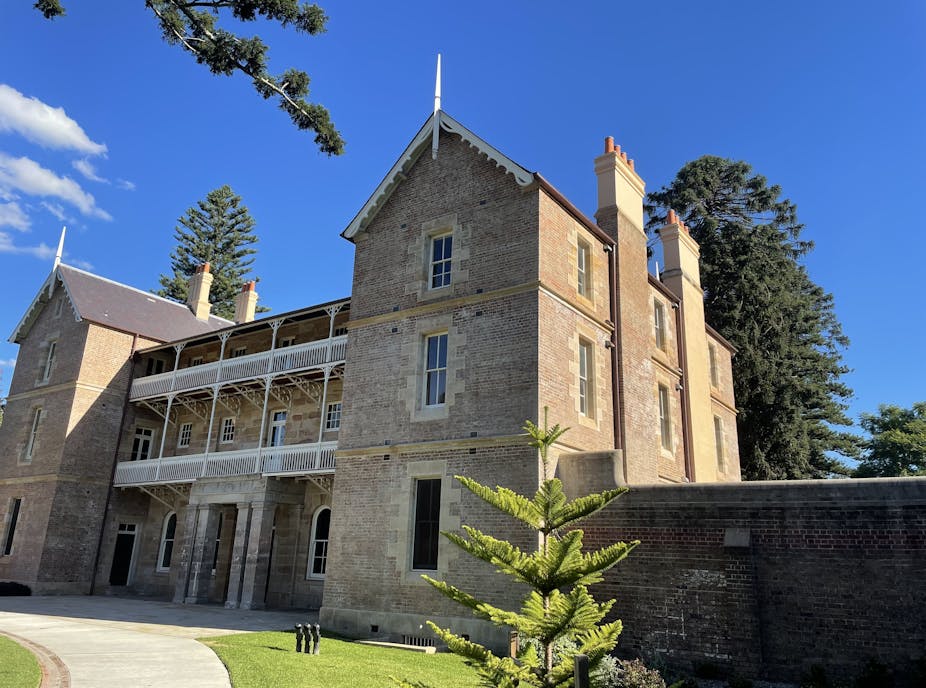Readers are advised this article discusses sexual abuse.
In the Sydney suburb of North Parramatta sits a cluster of very old buildings known as the “Parramatta Female Factory Precinct”.
Built in 1821 to house and provide productive employment for the New South Wales colony’s growing population of female convicts, it was also the site of countless horrors – many of which occurred much more recently than you might think.
The Australian government recently announced it will nominate the Parramatta Female Factory in Sydney for World Heritage listing. It is a worthy nomination; the site is deeply significant for the many wards of the state who survived institutionalisation here or in other parts of Australia.
This precinct is by no means merely a relic of the convict era. Only 15 years ago, part of the site was a women’s prison. And from 1887 to 1974, it housed the notorious Parramatta Girls’ Home.
The Parramatta Girls’ Home
The Girls’ Home was also known as Parramatta Girls’ Industrial School, Girls’ Training School, and Girls’ Training Home. Each name was very much a euphemism. Whatever you call it, it was a high-security institution. That is, a jail.
It was a place where adolescent girls who had been removed from abusive or unfit parents, found homeless, orphaned, or mandated by the courts as wards of the state could be indefinitely detained.
It was among the most infamous examples of what criminologists today call “penal welfare” – the practice of locking up children and adolescents who have committed no offence other than being poor, homeless, or simply unloved.
It was official policy to treat welfare inmates — already highly vulnerable and having committed no offence at all — like hardened criminals.
They suffered a cruel and humiliating regime of physical, psychological and sexual violence.
The most trivial infraction of the rules — or no infraction at all — attracted punishments such as forced silence, scrubbing floors (with a toothbrush), beatings, and solitary confinement in dark underground cells.
And aside from the trauma of being locked in a pitch-black dungeon, girls in solitary were routinely raped by male staff members.
So horrific was its record of abuses that the Royal Commission into Institutional Responses to Child Sexual Abuse treated it as a special case study.
The Commission heard testimony from former inmates who named former staff members as serial sex offenders. Many had since died, but others have been charged and received heavy prison sentences.
And it should be kept in mind that the Royal Commission’s terms of reference focused narrowly on sexual abuse. No prosecutions ensued for the myriad incidents of appalling, but non-sexual, emotional and physical maltreatment.
The stakeholders who so passionately advocated for the preservation and commemoration of the Parramatta Female Factory Precinct were survivors of the Girls’ Home.
In 2006 they formed a lobby group called “Parragirls”, and began campaigning for official acknowledgement of their experiences.
They called for the entire site — not just the convict-era building — to be recognised as historically significant and worthy of preservation.

It wasn’t the only institution
The Parragirls number a few hundred. They form a small subsection of the roughly half a million survivors of out-of-home “care” in the latter half of the 20th century, whom a 2003 Senate inquiry dubbed the “Forgotten Australians”.
I was a ward of the state as a teenager and spent time in various institutions as a child. As a Victorian, I was never in danger of being locked away in Parramatta, but its horrors were legendary among state wards everywhere.
We had our own institutions, many as brutal as Parramatta, to contend with and try to avoid.
Australia has not come to terms with what happened to wards of the state in the 20th century.
Many are still alive, but many lives have been ruined.
Institutions like Parramatta Girls and others investigated by various inquiries and by the Royal Commission remain relatively unknown to the general public.
For Forgotten Australians whose lives were not touched directly by Parramatta, the site nevertheless stands as an emblem of all the institutions that served Australia’s horrific “penal welfare” system.
Many of us endorse the campaign to have the entire site, not just the convict-era Female Factory, preserved and nominated for World Heritage recognition.
It has taken too long to recognise this history
World Heritage Listing defines the site as being “of outstanding universal value to humanity” and ensures it will be preserved.
If the Parramatta Female Factory Precinct makes it onto the World Heritage List, it will be only the second female convict factory site in Australia to do so, after the Cascades Female Factory in Tasmania.
Parramatta’s nomination, however, raises questions.
Older and larger than Cascades, it was the prototype of all female factories around Australia, and significantly more of it survives today than any other site. Yet it took years of campaigning to draw the government’s attention to it.
Sydney’s Hyde Park Barracks, a major convict prison for men, has been a tourist attraction for decades and has had World Heritage listing since 2010.
To overlook an even larger and equally significant site devoted to women of the same historical era is a rather glaring omission.
If this article has raised issues for you, or if you’re concerned about someone you know, call Lifeline on 13 11 14. The National Sexual Assault, Family and Domestic Violence Counselling Line – 1800 RESPECT (1800 737 732) – is available 24 hours a day, seven days a week for any Australian who has experienced, or is at risk of, family and domestic violence and/or sexual assault.

